Genre: Maze Developer: Michael Schwartz Publisher: Electronic Arts Players: 1-2 Released: 1991
Marble Madness is a classic game like no else. It was released in the arcades in 1984, with the later Sega employed Mark Cerny as the creator. It was ported to a lot of computers and consoles, with the Mega Drive port being one of the later ones. It was done by Michael Schwartz, who is falsely advertised as the creator of the game, when he is in fact only the porter. The guy even has an “Artist’s Bio” and a picture of him (together with the sound programmer, who we will get back to) at the first two pages of the manual. For shame!
From a isometric view, much like in Sonic 3D: Flickies’ Island and Landstalker: The Treasure of King Nole, you are controlling a ball with the simple aim to reach the goal on six levels. The ball can be controlled either like the D-pad’s directions, or by following the grid (like in Landstalker). You can also use the Atari 2600 trackball. For turbo mode, hold A, B or C when directing the ball.
To reach the goal, you have to fight against time, enemies and the level itself. The enemies that can destroy you are for example Acid Slime and birds called Pterodactyls. Others, like the black ball, hammers, and Marble Munchers are mostly just in your way to steal time. It doesn’t matter how many times your ball gets destroyed, because you always get a new one as long as you have time, but staying alive is best because death animations take time. When the clock ticks to zero, the game is over. You have only one chance to beat all six levels, but since the game can be completed in just a few minutes, it doesn’t matter. The time you have left when beating a level is given to you as a bonus in the next one. There are three difficulty settings, but the only difference between them is the amount of seconds you are given for each level. Like most of the games from the era, the aim is to get a good score rather than to see the epic ending. By defeating enemies, dying as few times as possible and finishing with as much time as possible, you will be able to get a higher score.
There is a competitive two-player mode. If one of the players has the other one get out of the screen, the leading player gets five extra seconds and the second one gets teleported close to him/her. One minor benefit of this mode is the different routes it gives the second player. It is also always nice to be able to play with a friend.
Despite being very close to the arcade, the graphics actually disappoint me. The colours are very bland and look like they have been in a washing machine with bleach. At least they are very clean and easy on your eyes, so you know what you are seeing and doing. The sprites are well animated, especially the ball itself. More and better use of colours shouldn’t be too much to ask for though.
The guy responsible for the sound in this version is named Steve Hayes. He might be a programmer, but he is certainly no musician. The music presented in this game is atrocious. It is noisy, most often without any thought out composition and it seriously nearly gave me a headache. The best part of it is the enjoyment you feel when it is finally off. Since it is present in other versions as well, Mister Hayes shouldn’t take full credit for it either. Whoever wants to put his name on something that sounds like a fire truck alarm which is supposed to act as music must lack education. The few sound effects are either anonymous or annoying. All in all, the sound of Marble Madness is worse than that of Dark Castle, a port from around the same time.
Marble Madness is quite a fun game, although a little frustrating in the end. It is original, addictive, plays pretty well, and has a two-player mode. It sounds like it should have a great score, right? Yes, but then we haven’t revealed all its shortcomings yet. For starters, a direct port of a seven year-old arcade game that can be beaten in minutes isn’t fit to be a Mega Drive game, something said by Mr. Cerny himself. You don’t want to pay 495 Swedish kronor on such a short game, so that is why I got my copy for 16 SEK, used.
Arcade ports seldom give the players what they want on the Mega Drive. If the arcade system is more advanced, the port naturally becomes worse and people complain about it. In the case of Marble Madness, the Mega Drive is almost powerful enough to make it arcade perfect, and the port almost is, so why complain? The game is on a 4 Mbit ROM, like the first Sonic, so there should be much more content added to justify the high price of a home version. More levels, updated graphics, listenable audio and new gameplay features are things that I’m talking about. A good example of a game that does this right is Pengo, a vastly improved home version on the Mega Drive.
Although the few minutes you play Marble Madness are enjoyable, the fun wears out due to the small amount of content that is repeated all the time. You can buy a bottle of soda for the same price, and just like it, the taste is best when first opened with the most carbonic acid. But once the bottle is emptied quickly, there is not much more to do than put it away or recycle it for more soda later. Marble Madness might be worth the few minutes of fun for a buck or two, just don’t expect an extraordinary, lengthy Mega Drive experience.
SCORE: 4 out of 10

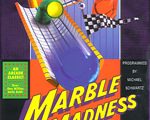
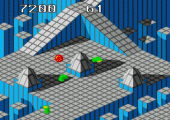
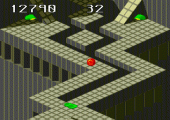
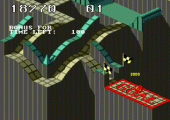
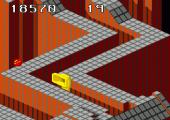
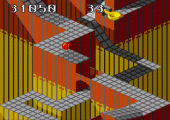
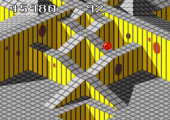
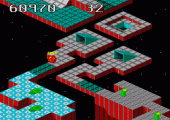
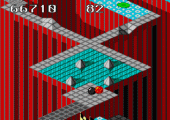
Before the site hack in 2011, I left a comment which I’ve just rediscovered:
“Graphics and gameplay are OK, though it doesn’t control as tightly as the NES version, I don’t like the new score font, and the game select screen is very laggy. But the real disaster is the music programming, which should’ve been arcade-perfect; instead the game’s beloved tunes are reduced to a distorted, glitchy mess (yes, I’m playing on real hardware). Shame on EA. Still, it’s playable enough.”
I’d also note that the reviewer’s complaints about the length of the game are kind of silly. Sure, additional modes could have been interesting, but the NES port didn’t have any, and it’s justly considered a classic for the console. For me, the arcade game itself is enough.
That said, the Tengen port (only released in Japan) is basically arcade-perfect, and blows this one out of the water completely.